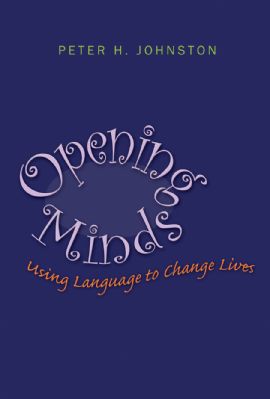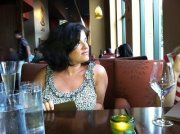Humanity’s Apprentices
Opening Minds: Using Language to Change Lives
By Peter H. Johnston
(Stenhouse, 2012 – Learn more)
Choosing your words is the single most important choice you can make as a teacher. Just ask Peter H. Johnston, who observed children moving from fixed theories about themselves to dynamic theories where, literally, their lives were transformed all by the choice of a word.
Johnston explains that “holding a fixed theory or a dynamic theory may seem like no big deal…(but) when children holding fixed theories encounter difficulties, their mistakes become crippling.” (p.11) They will, in fact, choose not to learn something in order to avoid looking stupid.

Johnston doesn’t want you to just take his word for it. He takes you firmly by the hand and shows how the addition of even just one word can create a mindset which dramatically transforms the path a person’s life will take. If a teacher moves a child from saying “I can’t write” to saying “I can’t write yet,” the world of possibilities is opened. He also shares about a classroom where a teacher says “thank you” to students instead of “good job” so that students feel useful in the function of the classroom instead of just “liked.” Children learn to participate because they want to learn and not because they want praise.
Each of the nine chapters in Opening Minds builds on the learning from the previous ones. He moves from Choosing Words through Performance, Feedback, and Dialogue into Social Imagination and Moral Development before sharing the importance of Thinking and Working Together. At one point, he shares a real classroom conversation where second graders are outraged that Thomas Jefferson, who once owned slaves, was allowed to be on the five-cent piece. Johnston explains that this is why slowing down and stepping back as a teacher, to allow for a dialogic classroom, creates children who think for themselves and actively seek to solve civic issues. It is an impressive conversation for anyone, let alone 7 and 8 year olds. Even Johnston stops at the end and writes a single sentence.
“I want my children and their children in a class like this.”
And we should too.
Sticky concepts
There were a few concepts that I couldn’t get out of my head long after I finished the book.
Johnston writes a lot about children needing to learn to be okay with uncertainty. He quotes Robert Altman as saying, “If you and I agreed about everything, then one of us is unnecessary.” We need to be willing to disagree in order to get to a place of new learning because (as we learned before) the more you learn, the smarter you’ll get. Johnston also observes that teachers are not just teaching academic facts, and this can be difficult.
“The problem with apprenticing children into humanity — the intellectual and social life of society — is that much of the action we want them to understand takes place inside people’s heads.” (p.69)
We have to teach children to read people’s minds, literally. Teachers need to ask students to look at the way people stand and how their eyes look and then figure out what that person is thinking about what is happening in that moment. I knew that, but when I read it I felt something in my brain crack wide open.
Johnston’s thinking is transformative. A review can barely do this groundbreaking book justice because he doesn’t just cover information, he builds on a theory with facts and observations and good old-fashioned common sense. He has created a layered effect of ideas and theories that form a solid path to becoming a master in the apprenticeship of children into humanity.
Kimberley Moran is an Academic Interventionist for an elementary school in southern Maine. She has a Master of Science in Literacy Education. Kimberley has worked as a literacy coach, elementary teacher, grant writer, public policy lobbyist, and Executive Director of Literacy Volunteers. Kimberly says she is “a master in the art of moving and changing.” She is concentrating on staying in one place, raising her children in Maine, teaching, reading, and writing. Kimberly blogs at First in Maine.































